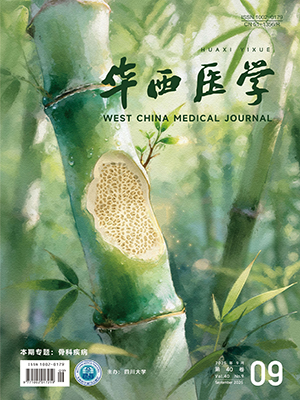| 1. |
Nkomo VT, Gardin JM, Skelton TN, et al. Burden of valvular heart diseases: a population-based study. Lancet, 2006, 368(9540): 1005-1011.
|
| 2. |
Goliasch G, Bartko PE, Pavo N, et al. Refining the prognostic impact of functional mitral regurgitation in chronic heart failure. Eur Heart J, 2018, 39(1): 39-46.
|
| 3. |
Sorajja P, Ukaigwe AC. Edge-to-edge repair: past challenge, current case selection and future advances. Ann Cardiothorac Surg, 2021, 10(1): 43-49.
|
| 4. |
Antoine C, Mantovani F, Benfari G, et al. Pathophysiology of degenerative mitral regurgitation: new 3-dimensional imaging insights. Circ Cardiovasc Imaging, 2018, 11(1): e005971.
|
| 5. |
Grayburn PA, Thomas JD. Basic principles of the echocardiographic evaluation of mitral regurgitation. JACC Cardiovasc Imaging, 2021, 14(4): 843-853.
|
| 6. |
Deferm S, Bertrand PB, Verbrugge FH, et al. Atrial functional mitral regurgitation: JACC review topic of the week. J Am Coll Cardiol, 2019, 73(19): 2465-2476.
|
| 7. |
Mesi O, Gad MM, Crane AD, et al. Severe atrial functional mitral regurgitation: clinical and echocardiographic characteristics, management and outcomes. JACC Cardiovasc Imaging, 2021, 14(4): 797-808.
|
| 8. |
Maisano F, Caldarola A, Blasio A, et al. Midterm results of edge-to-edge mitral valve repair without annuloplasty. J Thorac Cardiovasc Surg, 2003, 126(6): 1987-1997.
|
| 9. |
Maisano F, Torracca L, Oppizzi M, et al. The edge-to-edge technique: a simplified method to correct mitral insufficiency. Eur J Cardiothorac Surg, 1998, 13(3): 240-245, discussion 245-246.
|
| 10. |
St Goar FG, Fann JI, Komtebedde J, et al. Endovascular edge-to-edge mitral valve repair: short-term results in a porcine model. Circulation, 2003, 108(16): 1990-1993.
|
| 11. |
Condado JA, Acquatella H, Rodriguez L, et al. Percutaneous edge-to-edge mitral valve repair: 2-year follow-up in the first human case. Catheter Cardiovasc Interv, 2006, 67(2): 323-325.
|
| 12. |
Kataoka A, Watanabe Y, OCEAN-SHD Family. MitraClip: a review of its current status and future perspectives. Cardiovasc Interv Ther, 2023, 38(1): 28-38.
|
| 13. |
中国医师协会心血管内科医师分会结构性心脏病学组, 亚太结构性心脏病俱乐部. 中国经导管二尖瓣缘对缘修复术临床路径(2022 版)精简版. 中国介入心脏病学杂志, 2023, 31(3): 161-173.
|
| 14. |
Feldman T, Kar S, Rinaldi M, et al. Percutaneous mitral repair with the MitraClip system: safety and midterm durability in the initial EVEREST (Endovascular Valve Edge-to-Edge REpair Study) cohort. J Am Coll Cardiol, 2009, 54(8): 686-694.
|
| 15. |
Feldman T, Wasserman HS, Herrmann HC, et al. Percutaneous mitral valve repair using the edge-to-edge technique: six-month results of the EVEREST phase I clinical trial. J Am Coll Cardiol, 2005, 46(11): 2134-2140.
|
| 16. |
Mauri L, Garg P, Massaro JM, et al. The EVEREST II trial: design and rationale for a randomized study of the evalve mitraclip system compared with mitral valve surgery for mitral regurgitation. Am Heart J, 2010, 160(1): 23-29.
|
| 17. |
Feldman T, Kar S, Elmariah S, et al. Randomized comparison of percutaneous repair and surgery for mitral regurgitation: 5-year results of EVEREST II. J Am Coll Cardiol, 2015, 66(25): 2844-2854.
|
| 18. |
Stone GW, Lindenfeld J, Abraham WT, et al. Transcatheter mitral-valve repair in patients with heart failure. N Engl J Med, 2018, 379(24): 2307-2318.
|
| 19. |
Obadia JF, Messika-Zeitoun D, Leurent G, et al. Percutaneous repair or medical treatment for secondary mitral regurgitation. N Engl J Med, 2018, 379(24): 2297-2306.
|
| 20. |
Kar S, von Bardeleben RS, Rottbauer W, et al. Contemporary outcomes following transcatheter edge-to-edge repair: 1-year results from the EXPAND study. JACC Cardiovasc Interv, 2023, 16(5): 589-602.
|
| 21. |
von Bardeleben RS, Rogers JH, Mahoney P, et al. Real-world outcomes of fourth-generation mitral transcatheter repair: 30-day results from EXPAND G4. JACC Cardiovasc Interv, 2023, 16(12): 1463-1473.
|
| 22. |
Praz F, Windecker S, Kapadia S. PASCAL: a new addition to the armamentarium of transcatheter repair systems for mitral leaflet approximation. JACC Cardiovasc Interv, 2019, 12(14): 1379-1381.
|
| 23. |
Srinivasan A, Brown J, Ahmed H, et al. PASCAL repair system for patients with mitral regurgitation: a systematic review. Int J Cardiol, 2023, 376: 108-114.
|
| 24. |
Praz F, Spargias K, Chrissoheris M, et al. Compassionate use of the PASCAL transcatheter mitral valve repair system for patients with severe mitral regurgitation: a multicentre, prospective, observational, first-in-man study. Lancet, 2017, 390(10096): 773-780.
|
| 25. |
Webb JG, Hensey M, Szerlip M, et al. 1-year outcomes for transcatheter repair in patients with mitral regurgitation from the CLASP study. JACC Cardiovasc Interv, 2020, 13(20): 2344-2357.
|
| 26. |
Szerlip M, Spargias KS, Makkar R, et al. 2-year outcomes for transcatheter repair in patients with mitral regurgitation from the CLASP study. JACC Cardiovasc Interv, 2021, 14(14): 1538-1548.
|
| 27. |
Geis NA, Schlegel P, Heckmann MB, et al. One-year results following PASCAL-based or MitraClip-based mitral valve transcatheter edge-to-edge repair. ESC Heart Fail, 2022, 9(2): 853-865.
|
| 28. |
Schneider L, Markovic S, Mueller K, et al. Mitral valve transcatheter edge-to-edge repair using MitraClip or PASCAL: a multicenter propensity score-matched comparison. JACC Cardiovasc Interv, 2022, 15(24): 2554-2567.
|
| 29. |
Lim DS, Smith RL, Gillam LD, et al. Randomized comparison of transcatheter edge-to-edge repair for degenerative mitral regurgitation in prohibitive surgical risk patients. JACC Cardiovasc Interv, 2022, 15(24): 2523-2536.
|
| 30. |
Writing Committee Members, Otto CM, Nishimura RA, et al. 2020 ACC/AHA guideline for the management of patients with valvular heart disease: a report of the American College of Cardiology/American Heart Association Joint Committee on Clinical Practice Guidelines. J Thorac Cardiovasc Surg, 2021, 162(2): e183-e353.
|
| 31. |
Vahanian A, Beyersdorf F, Praz F, et al. 2021 ESC/EACTS Guidelines for the management of valvular heart disease. G Ital Cardiol (Rome), 2022, 23(Suppl 1): e1-e75.
|




